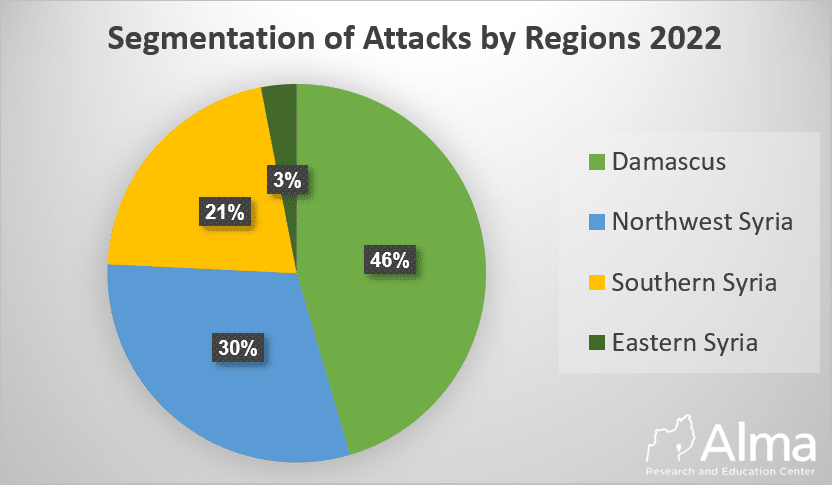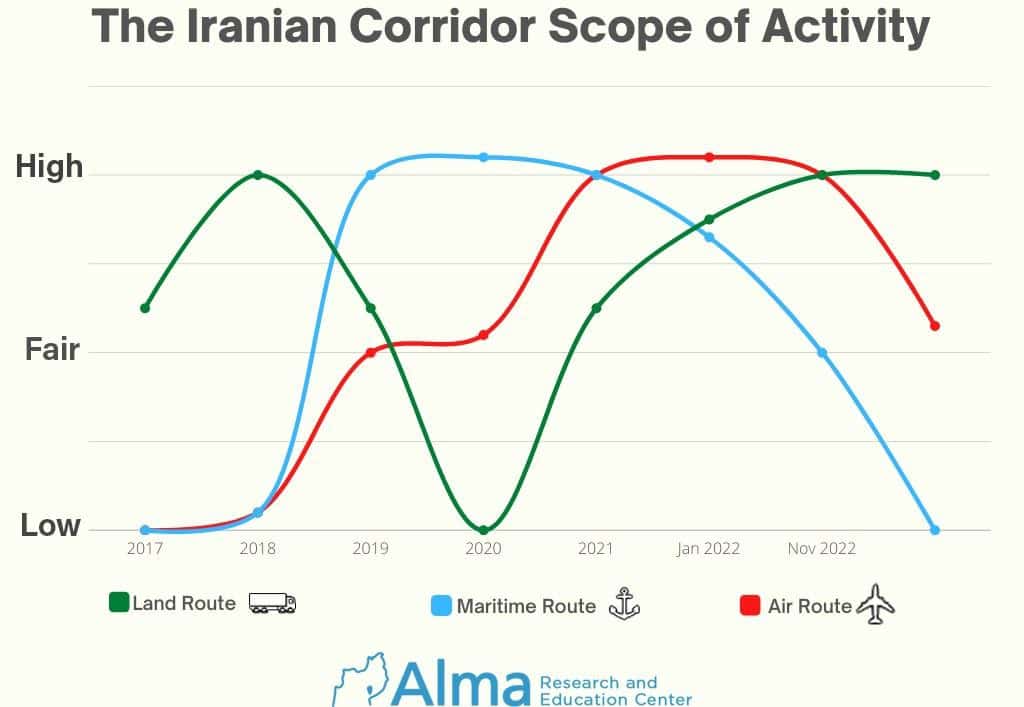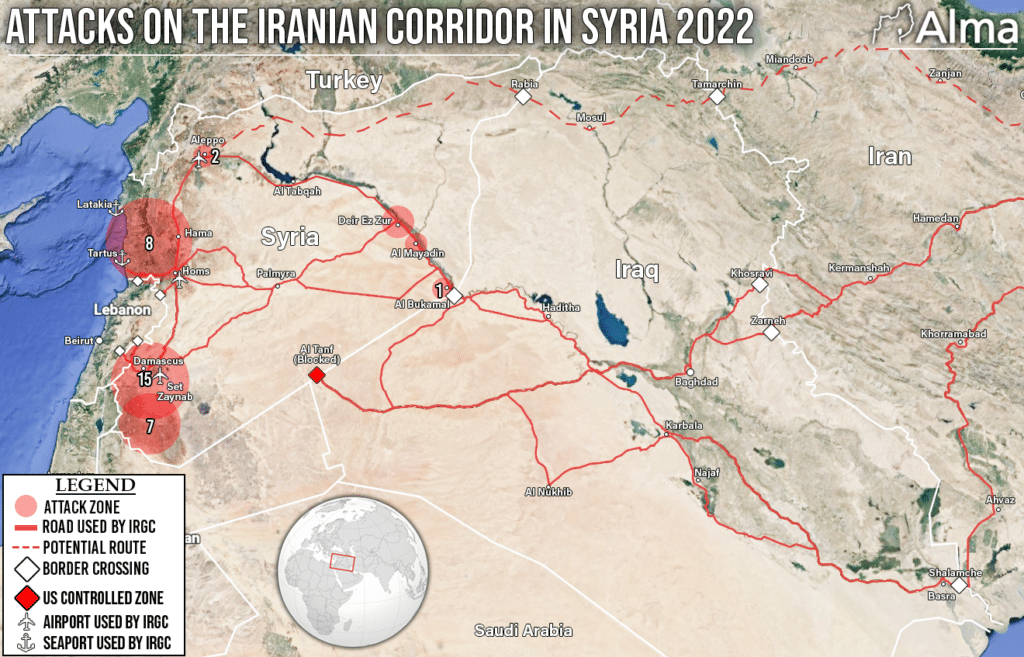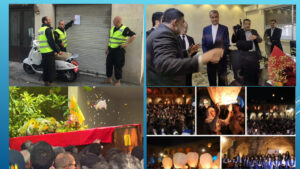What Occurred (2022) and What Will Transpire (2023)?
Review and Analysis
By: Teddy Sapir and Tal Beeri
General:
The objective of the MABAM (CBW), the “Campaign Between Wars,” attributed to Israel, is to disrupt Iranian arms transfers to Syria and Lebanon via land, air, and sea routes of the Iranian corridor and to undermine Iran’s military entrenchment in Syria and Hezbollah’s military power buildup in Lebanon (i.e., damage to military infrastructures and manufacturing and upgrading weapons plants of advanced quality conventional weapons, terrorist infrastructures, weapons, and functionaries that pose a “clear and immediate danger”). Another goal is to drive a wedge between Iran and Syria in light of the damage to Syrian infrastructures caused by this activity.
The CBW, throughout 2022, succeeded in disrupting the Iranian arms delivery via the corridor. However, even if the outcome of the campaign managed to drive a wedge between the Iranians and the Assad regime, in practice, it is not reflected due to President Assad’s weakness, who, besides being frustrated by the damage caused by the CBW, is unable to take operative action against the Iranians, who were a significant factor in his survival.
In 2022, the CBW did not address another major issue – the issue of the Iranian civilian entrenchment in Syria. The “model” for entrenching the Shiite axis consists of 2 aspects: the civilian and the military. The military aspect is dependent on the civilian element. If only the military aspect is impaired, it is considered “mowing the lawn” and not “uprooting it.”
The earthquake in early February 2023 in northwestern Syria fell like ripe fruit into Iranian hands.
From a civilian perspective, the resulting situation will allow the Iranians to better entrench themselves civilly while taking advantage of the dire humanitarian situation created by the earthquake
From a military perspective, the earthquake that occurred in Syria created a very large intelligence and conceptual challenge for the CBW in 2023. We estimate that from an intelligence perspective, the challenge will increase. The volume of civilian traffic to Syria via air, land, and sea will increase significantly under the title of “humanitarian aid.” From the conceptual perspective, an attack on weapons on Syrian soil will be met with a propaganda campaign (false, of course) led by the Shiite axis, which will claim that humanitarian aid intended for the earthquake disaster victims is being attacked and, of course, publicize photos of humanitarian equipment damaged due to these attacks.
Since the Iranians will continue on their own, the CBW campaign will also continue. It will be necessary to deal with the false propaganda campaign, possibly by the publication that will negate It.
The working assumption is that the IRGC will take full advantage of the situation in 2023 to intensify weapons smuggling into Syria and Lebanon.
This article will present and analyze the significance of the 33 airstrikes (see Appendix A for details) attributed to the 2022 CBW campaign in four geographic areas: Damascus, northwestern Syria, southern Syria, and eastern Syria. (It should be noted that each such attack included several targets. Therefore, the total number of targets attacked during 2022 is much greater than the number of attacks. Also, one attack included two different geographical areas and was counted by us as two separate attacks).
In addition, we will present five additional attacks (see Appendix B for details), some of which are attributed to the international coalition, and some are unclear whether they were carried out as part of the campaign attributed to Israel.
Analysis of the findings:
Most of the attacks attributed to Israel’s 2022 CBW were aimed at preventing the transfer of weapons destined for Hezbollah via the Iranian corridor into Syria and from there into Lebanon. This also refers to attacks against the manufacture and upgrading of weapons on Syrian soil at the various sites of the CERS installations. In addition, attacks were directed against the infrastructure of Hezbollah, Iran, and Shiite militias in Damascus and terrorist infrastructure in the Golan Heights.
15 airstrikes (46 percent of attacks) were carried out in the Damascus area, 10 ( 30 percent) in northwestern Syria, 7 airstrikes (21 percent) were carried out in southern Syria, and one attack (3 percent) was carried out in eastern Syria (Al-Bukamal).

In terms of the additional strikes, four of them were carried out in the area of eastern Syria and one in the area of Damascus.
15 airstrikes in the Damascus area. In 2022, the CBW succeeded in disrupting the transfer of high-quality weapons and advanced technology, such as precision project components, Iranian air-defense systems, and the transfer of UAVs and UAV parts. Much of the equipment listed above is transported to the Damascus area (via the land and air route) and is temporarily stored there in preparation for its transfer to Lebanon. In 2022, the Damascus area was the most central geographical anchor of the Iranian corridor, and the number of attacks indicates the amount of intelligence received in this regard. It should be noted that the Damascus area is an area where weapons are also stored for future use by the Shia axis inside Syria or against Israel. The Damascus area Emphasis on Saida Zeinab and its surroundings will continue to be a major geographical anchor throughout 2023.
See a special report on the Iranian establishment in Seyda Zeinab published by us in September 2022
10 airstrikes in northwestern Syria. In addition to the weapons transfers, there is also the production, upgrading, and storage of weapons at the various CERS installations. These activities are carried out under Iranian guidance, mainly at the CERS installations in northwestern Syria / Masyaf and in the Damascus area of Jamraya (a special and comprehensive report on the CERS Institute will be published by us at a later time). The airstrikes, which targeted hangars, warehouses, and buildings belonging to CERS sites, such as the sites at Jamraya and Masyaf, targeted locations where advanced conventional weapons designated for Hezbollah were manufactured and stored.
The Neyreb international airport in Aleppo is located in the geographical area of northwestern Syria. In 2022, “Neyreb” served as another major anchor of the Iranian air route corridor to Syria. Our assessment is that during 2022, not much intelligence was received regarding weapons transfers via the maritime route (mostly through the port of Latakia, located in northwestern Syria). Therefore, almost no attacks were carried out in that area.

7 airstrikes in southern Syria. In 2022, the campaign in southern Syria was characterized by the damage to infrastructures and the activity of the Shiite axis in general and Hezbollah in particular. These infrastructures and activities are assimilated into the military infrastructure of Syrian Army units in southern Syria (units that usually operate under the command of the 1st Corps and 4th Division). In addition, a targeted attack was carried out on terrorist infrastructures, emphasizing the Golan Heights Portfolio and the Southern Headquarters units.
Hezbollah continues to entrench itself militarily in southern Syria and in the Syrian Golan Heights. The entrenchment is carried out through the Southern Command unit, which closely cooperates with the Syrian army units deployed in southern Syria near the border with Israel. In addition, Hezbollah acts through clandestine squads of the “Golan Portfolio” unit, utilizing proxy squads of local residents, some of whom were injured, and some of whom were cautioned during 2022. In our assessment, this trend will continue in 2023.
One attack in eastern Syria. Indeed, in 2022, the campaign can be attributed to only one attack in eastern Syria. However, we assess that in 2023, the number of airstrikes in eastern Syria will increase, emphasizing the geographical strip between Al-Bukamal and Deir al-Zor. A geographical strip in the territory of Syria which is mostly under Iranian control. The Iranians will increase the volume of their ground operations in the corridor and continue concealing weapons caches in civilian truck convoys. This is especially true in light of the situation following the earthquake that occurred in February 2023.
Summary:
The CBW is made possible by a very powerful intelligence capability. However, the CBW activity is not airtight. The transfer of weapons and the manufacture of weapons went on and will continue to go on. It is estimated that in 2022, about 70 percent of the known weapons transfers were disrupted and stopped, with about a 90 percent success rate damaging the known weapons production infrastructures on Syrian soil.
Iran and Hezbollah continue operating in Syria, despite the damage inflicted on the Syrian infrastructure. Bashar al-Assad has no real ability to reduce the activities of the Shiite axis in Syria and prevent the transfer of weapons through his territory. He also apparently will not do so since he is part of the Shiite axis of resistance. Moreover, Iranian and Hezbollah activity at the various sites of the CERS installations deepens Syria’s dependence on Iranian support since the manufacture and improvement of weapons are also supposed to help the Syrian army.
The CBW aims to achieve as many military achievements as possible to disrupt the entrenchment and transfers of Iran and Hezbollah’s weapons in Syria. The pace of attacks in the framework of the CBW is intensifying. The attacks are carried out in accordance with the understanding of the threat deriving from the transfer of advanced weapons to Syria and Hezbollah in Lebanon and in accordance with the intelligence and the possibility to exploit the opportunities in accomplishing the attacks. There is no doubt that the covert and overt activity of the CBW will continue and even increase.
The Russians do not constitute an operational and military obstacle to the CBW and cannot stop it if we only consider the military aspect. On the one hand, the growing ties of interest between Russia and Iran are changing the former’s priorities, which is to Israel’s detriment. On the other hand, the Russian resources directed to the war in Ukraine and the competition with Iran for influence in Syria are in Israel’s favor.
During 2022, the Iranians made extensive use of the land route as part of the corridor that runs from Iran via Iraq to central-eastern Syria in the geographical area of Al-Bukamal-Deir ez-Zor. This is in light of the operational difficulties they encountered in the air and at sea and in light of the exposure of this activity, even though it was carried out under full civilian cover (See the special report published by us in October 2022 on the Iranian corridor to Syria and Lebanon).
In our assessment, the earthquake creates an operational opportunity for the Iranians. It will enable them throughout 2023 to have optimal civilian cover for their military activities in Syria in general and their activities within the corridor in particular.






